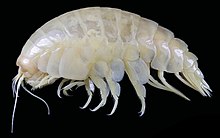
The Challenger Deep is the deepest known point of the seabed of Earth, located in the western Pacific Ocean at the southern end of the Mariana Trench, in the ocean territory of the Federated States of Micronesia.

The Mariana Trench is an oceanic trench located in the western Pacific Ocean, about 200 kilometres (124 mi) east of the Mariana Islands; it is the deepest oceanic trench on Earth. It is crescent-shaped and measures about 2,550 km (1,580 mi) in length and 69 km (43 mi) in width. The maximum known depth is 10,984 ± 25 metres at the southern end of a small slot-shaped valley in its floor known as the Challenger Deep. The deepest point of the trench is more than 2 km (1.2 mi) farther from sea level than the peak of Mount Everest.

Amphipoda is an order of malacostracan crustaceans with no carapace and generally with laterally compressed bodies. Amphipods range in size from 1 to 340 millimetres and are mostly detritivores or scavengers. There are more than 9,900 amphipod species so far described. They are mostly marine animals, but are found in almost all aquatic environments. Some 1,900 species live in fresh water, and the order also includes the terrestrial sandhoppers such as Talitrus saltator and Arcitalitrus sylvaticus.

The snailfishes or sea snails, are a family of marine ray-finned fishes. These fishes make up the Liparidae, which is classified within the order Scorpaeniformes.

An abyssal plain is an underwater plain on the deep ocean floor, usually found at depths between 3,000 and 6,000 metres. Lying generally between the foot of a continental rise and a mid-ocean ridge, abyssal plains cover more than 50% of the Earth's surface. They are among the flattest, smoothest, and least explored regions on Earth. Abyssal plains are key geologic elements of oceanic basins.
The abyssal zone or abyssopelagic zone is a layer of the pelagic zone of the ocean. The word abyss comes from the Greek word ἄβυσσος (ábussos), meaning "bottomless". At depths of 4,000–6,000 m (13,000–20,000 ft), this zone remains in perpetual darkness. It covers 83% of the total area of the ocean and 60% of Earth's surface. The abyssal zone has temperatures around 2–3 °C (36–37 °F) through the large majority of its mass. The water pressure can reach up to 76 MPa.
The hadal zone, also known as the hadopelagic zone, is the deepest region of the ocean, lying within oceanic trenches. The hadal zone ranges from around 6 to 11 km below sea level, and exists in long, narrow, topographic V-shaped depressions.
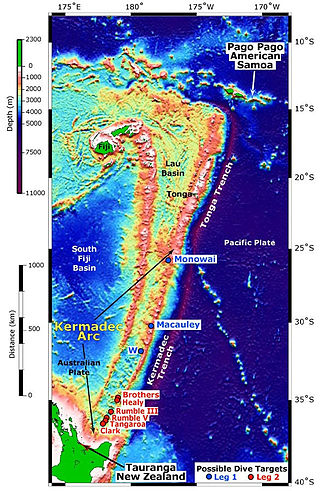
The Kermadec Trench is a linear ocean trench in the south Pacific Ocean. It stretches about 1,000 km (620 mi) from the Louisville Seamount Chain in the north (26°S) to the Hikurangi Plateau in the south (37°S), north-east of New Zealand's North Island. Together with the Tonga Trench to the north, it forms the 2,000 km (1,200 mi)-long, near-linear Kermadec-Tonga subduction system, which began to evolve in the Eocene when the Pacific Plate started to subduct beneath the Australian Plate. Convergence rates along this subduction system are among the fastest on Earth, 80 mm (3.1 in)/yr in the north and 45 mm (1.8 in)/yr in the south.
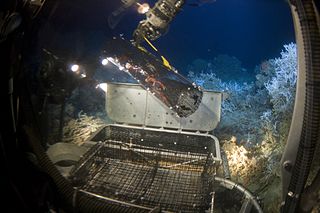
Deep-sea exploration is the investigation of physical, chemical, and biological conditions on the ocean waters and sea bed beyond the continental shelf, for scientific or commercial purposes. Deep-sea exploration is an aspect of underwater exploration and is considered a relatively recent human activity compared to the other areas of geophysical research, as the deeper depths of the sea have been investigated only during comparatively recent years. The ocean depths still remain a largely unexplored part of the Earth, and form a relatively undiscovered domain.
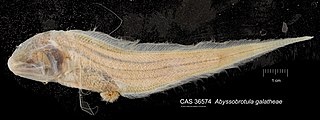
Abyssobrotula galatheae is a species of cusk eel in the family Ophidiidae. It is the deepest-living fish known; one specimen, trawled from a depth of 8,370 m (27,460 ft) in the Puerto Rico Trench in 1970, holds the record for the deepest fish ever captured. Although generally recognized, some have suggested that the record-breaking individual might have been caught with a non-closing net and therefore perhaps caught shallower.

Alicella gigantea is the largest species of amphipod ever observed, with some individuals reaching up to 34 centimetres (13 in) long. The average length of A. gigantea ranges from 72.5 to 141.0 millimeters, and its weight ranges from 4.2 to 45 grams. Comparatively to other amphipods, the A. gigantea grows at a much faster rate. Formerly included in the family Lysianassidae, a new family, Alicellidae, was erected in 2008 for Alicella and five related genera. The species lives only at great depths; the first specimens were collected at the end of the 19th century from the Madeira Abyssal Plain, and subsequent specimens have been found in other abyssal plains of both the Atlantic and Pacific Oceans, as well as from the Kermadec Trench in the southwest Pacific. One specimen was found in the stomach of a black-footed albatross, but is thought to have been dead before it was eaten.
Trophomera marionensis is a deep-sea nematode endoparasite of the family Benthimermithidae. They can be found in one of the deepest parts of the ocean, for example, in the hadal zone 7,000 to 10,000 meters below sea level. They exist in relentless darkness under immense water pressure. Marine invertebrates are their definitive hosts. They infest a wide range of invertebrate marine hosts: polychaete, priapulids, crustaceans, and even other nematodes. Death of their host can result if they occupy the entire body, at which point they exit and reproduce.

Pseudoliparis swirei, the Mariana snailfish or Mariana hadal snailfish, is a species of snailfish found at hadal depths in the Mariana Trench in the western Pacific Ocean. It is known from a depth range of 6,198–8,076 m (20,335–26,496 ft), including a capture at 7,966 m (26,135 ft), which is possibly the record for a fish caught on the seafloor. Various anatomical, physiological, molecular and genetic adaptions help this species survive in such depths.

Eurythenes is a genus of marine amphipods in the family Eurytheneidae.
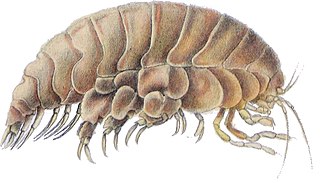
Eurythenes gryllus is a relatively large species of amphipod found worldwide in cold, deep oceans. This widespread and often common species is benthic and lives at depths of 550–7,800 m (1,800–25,600 ft).

Alan John Jamieson is a Scottish marine biologist, engineer, explorer and author, best known for his deep-sea exploration and study of life at the deepest places in the oceans. He is known for extensive use of deep-sea landers to establish the maximum depth and community dynamics of many organismal groups, as well as the discovery of many new species and highlighting the presence of anthropogenic impacts at full ocean depth. During the Five Deeps Expedition, and follow on expeditions in 2020, he completed various dives in a manned submersible to some of the deepest places in the world. He has published over 100 scientific papers and participated in 65 deep-sea expeditions.
Eurythenes thurstoni is a species of amphipod of the genus Eurythenes. It was first described in 2004 and named after Mike Thurston, a marine biologist specialising in deep-sea amphipods.

Eurythenes atacamensis is a species of amphipod restricted to the Peru-Chile ocean trench.
Pseudoliparis belyaevi is a species of snailfish found in hadal zone of the Northwest Pacific Ocean, particularly the Japan Trench.
Dulcibella camanchaca is a species of amphipod crustacean discovered in the Atacama Trench, at depths of nearly 8,000 m (26,000 ft) in the South Pacific Ocean near Chile. Measuring approximately 4 cm (1.6 in) in length, this predatory amphipod is adapted to the extreme conditions of the hadal zone, making it one of the deepest-living predators identified to date.
